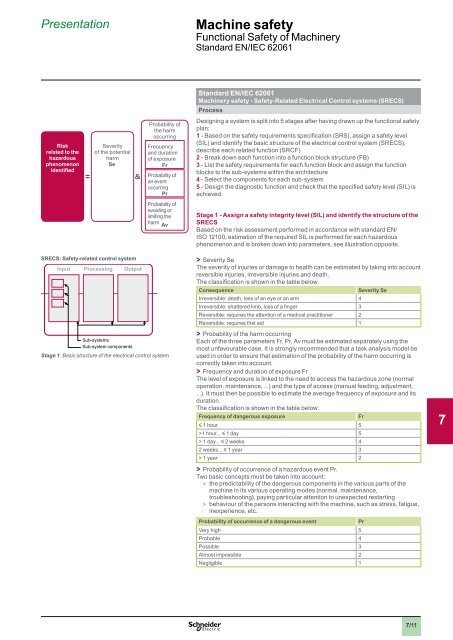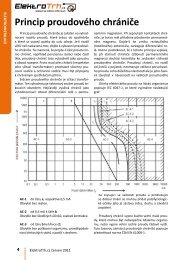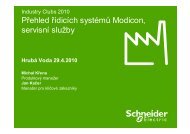2 - Schneider Electric CZ, s.r.o.
2 - Schneider Electric CZ, s.r.o.
2 - Schneider Electric CZ, s.r.o.
Create successful ePaper yourself
Turn your PDF publications into a flip-book with our unique Google optimized e-Paper software.
Presentation<br />
Machine safety<br />
Functional Safety of Machinery<br />
Standard EN/IEC 62061<br />
Risk<br />
related to the<br />
hazardous<br />
phenomenon<br />
identified<br />
SRECS: Safety-related control system<br />
Input<br />
Severity .<br />
of the potential<br />
harm<br />
Se<br />
Processing<br />
Output<br />
Probability of<br />
the harm<br />
occurring<br />
Frequency<br />
and duration<br />
of exposure<br />
Fr<br />
Probability of<br />
an event<br />
occurring<br />
Pr<br />
Probability of<br />
avoiding or<br />
limiting the<br />
harm Av<br />
Sub-systems<br />
Sub-system components<br />
Stage 1: Basic structure of the electrical control system<br />
Standard EN/IEC 62061<br />
Machinery safety - Safety-Related <strong>Electric</strong>al Control systems (SRECS)<br />
Process<br />
Designing a system is split into 5 stages after having drawn up the functional safety<br />
plan:<br />
1 - Based on the safety requirements specification (SRS), assign a safety level<br />
(SIL) and identify the basic structure of the electrical control system (SRECS),<br />
describe each related function (SRCF)<br />
2 - Break down each function into a function block structure (FB)<br />
3 - List the safety requirements for each function block and assign the function<br />
blocks to the sub-systems within the architecture<br />
4 - Select the components for each sub-system<br />
5 - Design the diagnostic function and check that the specified safety level (SIL) is<br />
achieved.<br />
Stage 1 - Assign a safety integrity level (SIL) and identify the structure of the<br />
SRECS<br />
Based on the risk assessment performed in accordance with standard EN/<br />
ISO 12100, estimation of the required SIL is performed for each hazardous<br />
phenomenon and is broken down into parameters, see illustration opposite.<br />
> > Severity Se<br />
The severity of injuries or damage to health can be estimated by taking into account<br />
reversible injuries, irreversible injuries and death.<br />
The classification is shown in the table below:<br />
Consequence<br />
Severity Se<br />
Irreversible: death, loss of an eye or an arm 4<br />
Irreversible: shattered limb, loss of a finger 3<br />
Reversible: requires the attention of a medical practitioner 2<br />
Reversible: requires first aid 1<br />
> > Probability of the harm occurring<br />
Each of the three parameters Fr, Pr, Av must be estimated separately using the<br />
most unfavourable case. It is strongly recommended that a task analysis model be<br />
used in order to ensure that estimation of the probability of the harm occurring is<br />
correctly taken into account.<br />
> > Frequency and duration of exposure Fr<br />
The level of exposure is linked to the need to access the hazardous zone (normal<br />
operation, maintenance, ...) and the type of access (manual feeding, adjustment,<br />
...). It must then be possible to estimate the average frequency of exposure and its<br />
duration.<br />
The classification is shown in the table below:<br />
Frequency of dangerous exposure<br />
Fr<br />
y 1 hour 5<br />
>1 hour... y 1 day 5<br />
> 1 day... y 2 weeks 4<br />
2 weeks... y 1 year 3<br />
> 1 year 2<br />
> > Probability of occurrence of a hazardous event Pr.<br />
Two basic concepts must be taken into account:<br />
> > the predictability of the dangerous components in the various parts of the<br />
machine in its various operating modes (normal, maintenance,<br />
troubleshooting), paying particular attention to unexpected restarting<br />
> > behaviour of the persons interacting with the machine, such as stress, fatigue,<br />
inexperience, etc.<br />
Probability of occurrence of a dangerous event<br />
Pr<br />
Very high 5<br />
Probable 4<br />
Possible 3<br />
Almost impossible 2<br />
Negligible 1<br />
1<br />
2<br />
3<br />
4<br />
5<br />
6<br />
7<br />
8<br />
9<br />
10<br />
7/11
















